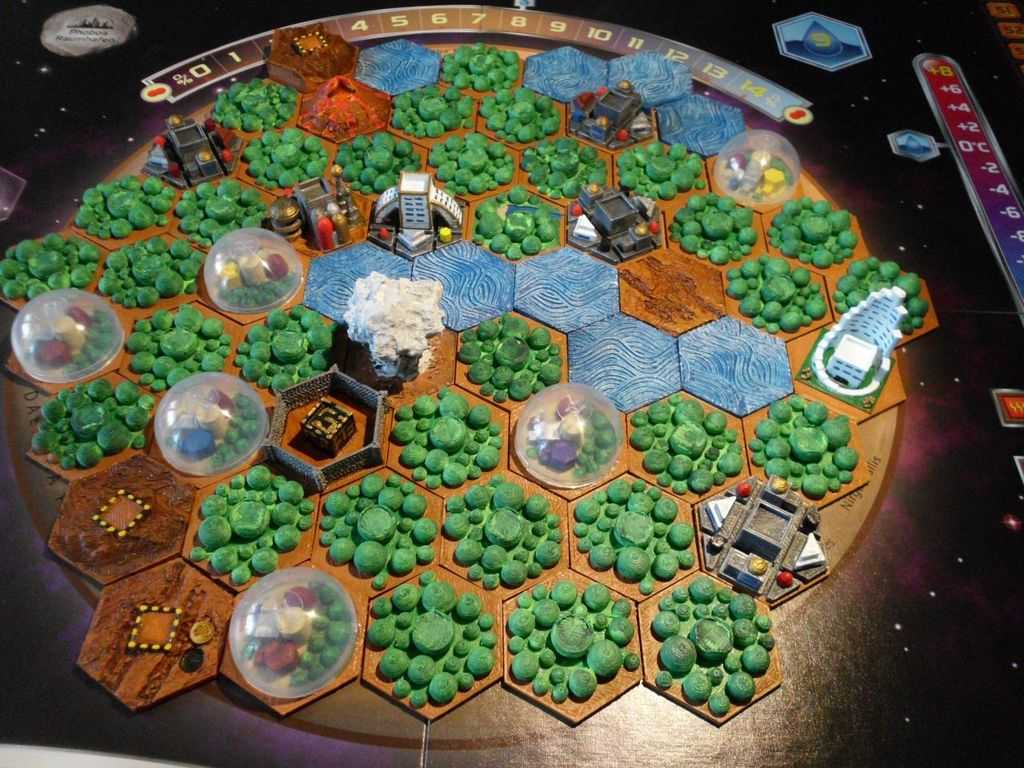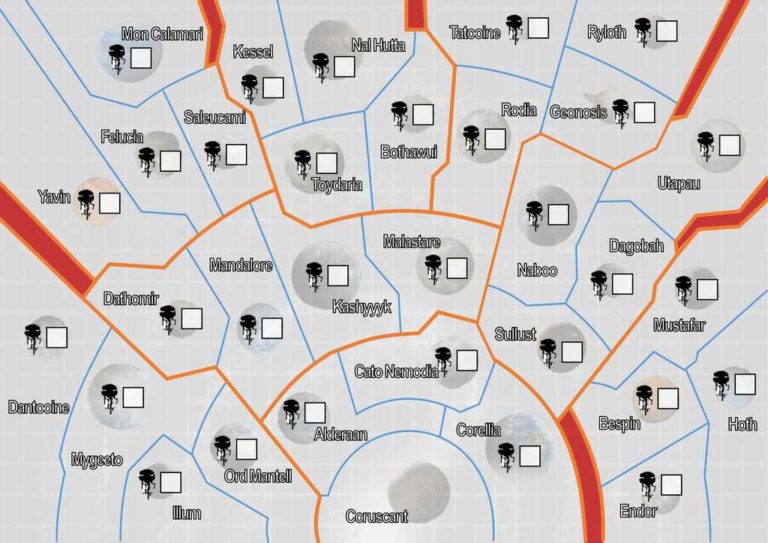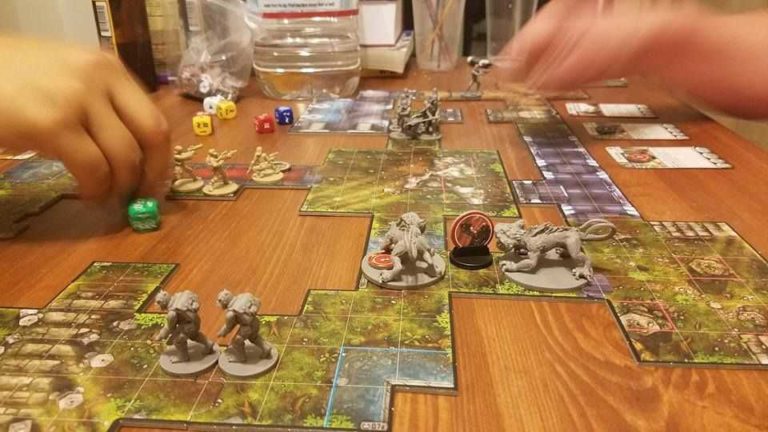Efficient Terraforming Mars Review
Efficient Terraforming Mars Review
Exploring the red planet has always been a fascination for so many of us, hasn’t it? That’s precisely why the board game Terraforming Mars hooks me every time. You might feel the same once you discover its intricate dance of resource management and strategic planning, all within the vast expanse of Mars’ dunes and plateaus. Imagine transforming a barren wasteland into a thriving biosphere – that’s the heart of Terraforming Mars. Having spent countless hours maneuvering through the economic considerations, project ventures, and terraforming processes, I’m eager to share the deep satisfaction and the brain-tickling challenges this game offers.
Key Points:
- Terraforming Mars is a complex and immersive board game that simulates the transformation of Mars into a habitable environment.
- The game involves resource management, strategic planning, and competition among players to leave the most significant impact on Mars.
- The core gameplay focuses on balancing short-term gains with the long-term goal of fully terraforming Mars by increasing oxygen levels, temperature, and ocean coverage.
- The game’s components and materials are of high quality, enhancing the immersive experience and adding to the strategic depth of the game.
- Terraforming Mars offers high replay value, with expansions adding new layers of strategy and complexity to the game.
- The game appeals to players who enjoy deep strategy, long-term planning, and thematic board games, as well as those who appreciate solo and competitive gameplay experiences.
In this Terraforming Mars review, I plan to walk you through the maze of mechanics that make this game a modern classic and a staple on my game shelf. The experience of Terraforming Mars goes beyond simple entertainment; it’s an immersive simulation that offers a complex tableau where every turn can shape the fate of your burgeoning Martian corporation. My journey saw me starting as a casual player, enamored by the thematic depth, and eventually morphing into a strategist ruthlessly optimizing every card and resource.
Each game session is a narrative of progress and competition, with friends and family all vying to leave the most indelible mark on Mars. Whether new to board gaming or an old hand looking for a fresh challenge, join me in evaluating the multifaceted aspects that make Terraforming Mars a remarkable game. From the alluring artwork and durable components to the immense replayability – every element contributes to an epic saga of galactic proportions.
A Deep Dive into Terraforming Mars Mechanics
Terraforming Mars is not just a game – it’s a strategic odyssey that demands attention to detail and careful planning. With a gameplay engine as intricate as the ecosystems you’re striving to create, understanding its gears and levers is crucial for mastering the game. Let’s delve into the core mechanics that give Terraforming Mars its rich and rewarding gameplay experience.
Core Gameplay and Objectives
The core of Terraforming Mars lies in its ability to simulate the transformation of the planet into a habitable environment. Players assume the roles of corporations racing to terraform Mars by increasing the oxygen level, temperature, and ocean coverage on the planet. At its essence, it’s about balancing the short-term gains of individual projects against the long-term goal of a fully terraformed Mars. Throughout this strategic journey, you will be collecting resources, playing project cards, and populating the board with greenery and city tiles.
Remembering my first playthrough, the game’s climax involved me narrowly hitting the terraforming targets, a victory sweetened by the tension of the preceding generations. Achieving milestones and claiming awards for my efforts added layers of strategy to my decisions. Was I to focus on planting forests to produce oxygen, or should I mine the moons of Mars to increase my heat production? Each path offered unique advantages and opportunities for points, which could ultimately lead to victory or defeat through the game’s scoring system.
Terraforming Mars is a strategic game where players race to transform the planet by balancing short-term gains with the long-term goal of fully terraforming Mars.
The Role of Cards in Strategy Development
Cards in Terraforming Mars aren’t merely functional – they’re the lifeblood of your strategic maneuvering and growth. With an expansive deck at your disposal, no two games ever unfold the same way. Players draft these cards, representing diverse projects that range from introducing plant life to initiating massive urban projects. Each card has a cost and often requires certain conditions on Mars to be met before it can be played.
I recall one game where I held a powerhouse card, but Mars wasn’t warm enough to use it – frustrating, yet brilliantly thematic. The card management is a majestic puzzle where timing and resource allocation are keys to success. It’s this interplay of project cards that drives your corporate engine, entwining your fate with the sway of the Martian sands. Some cards will mesh beautifully with your burgeoning ecosystem, while others will be scrapped for resources – it’s a delicate balance of selection and sacrifice.
Resource Management and Corporate Dynamics
The most profound moments in Terraforming Mars often come from the elegant simplicity of its resource system intertwined with the distinct corporate powers each player wields. Be it funding a formidable steel empire or laying the groundwork for a sustainable energy source, the game’s resources – steel, titanium, plant, energy, and heat – form the core of your strategic decisions.
Admittedly, I’ve kicked myself over mismanagement of resources; an early investment in energy didn’t pan out as I had diverted funds that could have boosted my plant production. This is the corporate dynamic at play: players must pivot their strategies to adapt to the fluctuating resource market, anticipating needs several turns ahead. Every corporation brings its own strengths to the table, which can significantly influence your tactical approach in accumulating and deploying your resources.

Components and Game Materials
Talk to any board game aficionado, and they’ll tell you that a game’s physical components can profoundly affect the play experience. In Terraforming Mars, the tangible materials are much more than mere trinkets; they are tools that immerse you in the terraforming endeavor and facilitate the strategic masterpiece that unfolds with each session.
Quality and Design of Game Pieces
As I unboxed Terraforming Mars for the first time, the tactile sensation of the game pieces added a layer of anticipation to the coming challenge. The design and quality of game pieces in Terraforming Mars range from durable player boards, representing the corporations, to the spherical resource tokens that one joyfully collects. The tiles that players place on Mars are sturdy and a pleasure to handle, conjuring an aura of permanence as you physically shape the Martian landscape with forests, cities, and special landmarks.
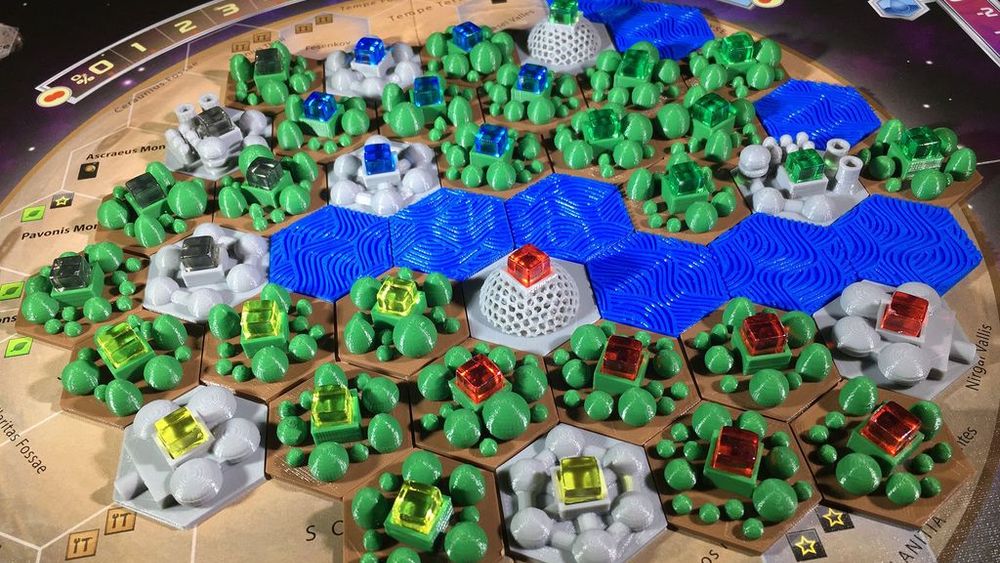
The richness of the game extends to these components, as they serve as a physical representation of your growing influence on Mars. On many an evening, I’ve admired the clever token design, each meticulously crafted to evoke industrial, natural, or scientific advancements. Visually, they not only add color to the board but also trigger strategic contemplation as the game progresses.
The Player Boards: Functionality and Aesthetics
Player boards in Terraforming Mars serve a dual purpose: functional hubs for resource tracking and aesthetically pleasing components that elevate the gaming experience. Each board is a command center, where strategies are born from the raw materials at our disposal. They are the visual diaries of our successes and miscalculations, boldly displaying our resource production and inventory.
The moment I laid eyes on these boards, I appreciated their thematic resonance – the grid layout, reminiscent of high-tech control systems, pushed me deeper into the role of a space-age executive. With different compartments for each resource, the boards keep play organized and visually enthralling, and one can’t help but feel a spark of pride as those tracks fill up with glittering cubes of potential wealth.
Player boards in Terraforming Mars are both functional hubs for resource tracking and aesthetically pleasing components that elevate the gaming experience.
The Learning Curve for New Players
Approaching the vast landscapes of Mars, both on the board and within the game’s mechanics, can be overwhelming for new players. However, don’t let the complexity of Terraforming Mars dissuade you – the game offers a rich and rewarding experience once you surmount the initial ascent of the learning curve.
Understanding the Rules: A Step-by-Step Guide
- Begin by familiarizing yourself with the game’s objective: successfully terraform Mars by raising its temperature, oxygen level, and ocean coverage.
- Next, get to know your corporation, its starting resources, and any unique abilities that will set the course of your gameplay.
- Dive into the project cards, taking the time to understand the requirements and benefits of each.
This sequential approach has eased many of my friends into the flow of the game, transforming initial bewilderment into strategic contemplation. It’s not mere rule memorization; it’s about absorbing the logic behind the game’s design, allowing you to naturally progress from producing resources to launching ambitious projects.
Tips for First-Time Players
For those dipping their toes into Terraforming Mars, here are practical tips to aid your inaugural journey:
- Focus on the main resources first – steel and titanium add value to certain projects, but ensuring a steady income of plants, energy, and heat is essential.
- Keep an eye on the endgame scoring from the start – cities and greenery will significantly boost your points, so strategize with that horizon in sight.
With these tips in mind, I’ve watched rookies evolve into contenders, their eyes lighting up as they chain together actions that once seemed daunting. Embrace the intricate dance, and soon you’ll weave through Terraforming Mars’ turns like a seasoned planet reshaper.
Game Experience Across Different Player Counts
The number of fellow terraformers at the table can dramatically alter the gameplay of Terraforming Mars, with shifts in strategy and interaction as you move from solo campaigns to a bustling board of prospective Martians.
Solo Play Versus Multiplayer Dynamics
Playing Terraforming Mars solo is like embarking on your own Martian odyssey; it’s you against the planet, with no other corporations to obstruct your path. The goal shifts to achieving a fully terraformed Mars within a set number of generations – converting it from a desolate wasteland to a verdant oasis at your sole discretion. It’s a unique puzzle, both challenging and gratifying, where your efficiency is sorely tested.
Transitioning to multiplayer, the dynamic morphs entirely. With friends, the game becomes a bustling marketplace of strategies, with negotiations and rivalries. My three-player sessions have often been the sweet spot, where drafting adds a layer of foresight and competitive tension without overextending the game’s length. As you add more players, the social fabric weaves tighter, crafting a tale where our corporate legacies intertwine and compete on the crimson plains of Mars.
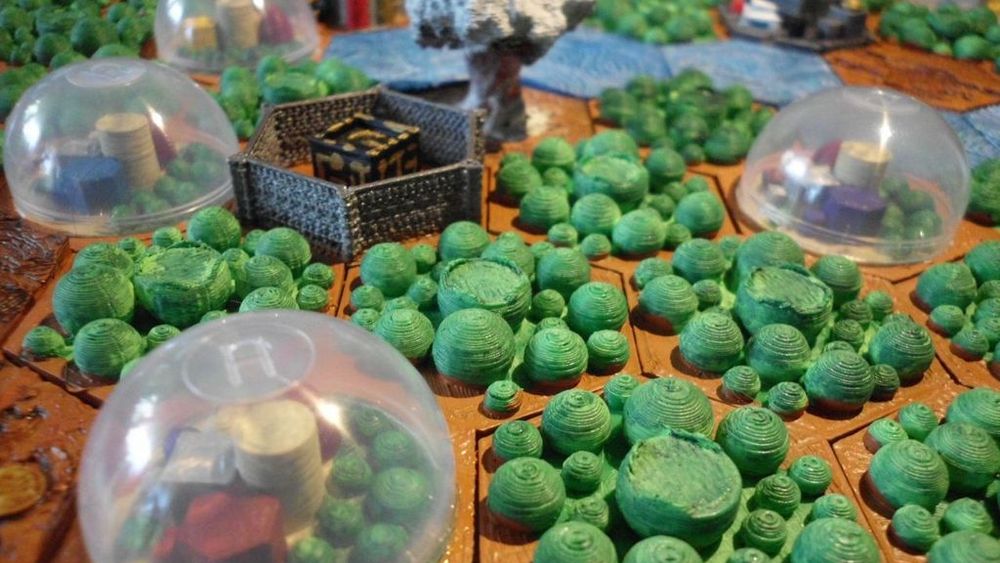
How Player Interaction Shapes the Game
In multiplayer Terraforming Mars, the arch of interaction is clear – every decision has the potential to aid or hinder your opponents. Placement of greenery can spark contests over territory, and milestone races can edge out players by a hair. Hand in hand with collaboration, there’s also subtle sabotage, as project cards can occasionally derail others’ well-laid plans.
I fondly remember sessions that pivoted on a single well-timed action. A forest planted that cut off an opponent’s city expansion, for instance, or an award claimed just before another was to claim it. It’s this tapestry of interactions – sometimes harmonious, often competitive – that makes every multiplayer game a unique narrative, embroidered with the personalities at the table.
Every decision in multiplayer Terraforming Mars has the potential to aid or hinder opponents, sparking contests over territory and milestone races, and creating a tapestry of interactions that makes each game a unique narrative.
The Expansion Packs: Enhancing the Base Game
The herald of any exceptional board game is the anticipation for more – the expansions. Terraforming Mars is no exception; the game’s rich base invites additional layers of strategy through a collection of expansions. Each expansion extends the narrative of your corporate saga, intertwining new project cards, rules, and terraforming elements with the established engine of the base game. How do these expansions alter the Martian landscape? Let me guide you through their transformative effects.
Overview of Available Expansions
Let me tell you about the buffet of expansions that Terraforming Mars has laid out for us intrepid terraformers. First, we’ve got Prelude, which is like a burst of nitro for your engine-building, providing powerful starting bonuses that propel you forward. Then there’s the Venus Next expansion, where you’ll venture beyond Mars to bring life to Venus – it adds a whole new layer of strategy with additional milestones and awards.
Hellas and Elysium offer a new map and opportunities; it’s like seeing Mars through a whole new lens each time you play. With Colonies, you’ll zoom out to build trading outposts in outer space, gaining unique benefits that can turn the tide of your corporation’s fate. And if you think the politics of Earth are complex, just wait till you see the intrigue and policy-making in the Turmoil expansion, which brings Mars to life with events and governmental shifts. Each of these sets enriches the base game in its own way, making your strategy for terraforming not just broader, but astronomically more dynamic.
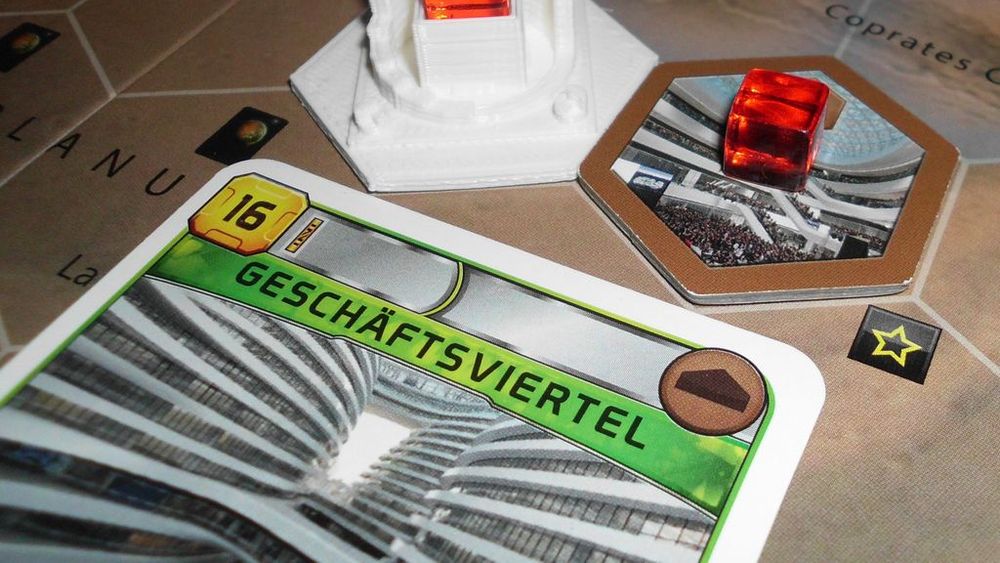
How Each Expansion Changes the Game
Each expansion for Terraforming Mars is like adding a new instrument to an orchestra. For example, Prelude accelerates the opening phases, letting players develop their corporations faster and dive into deeper strategies from the get-go. The Venus Next expansion interjects a new celestial body to consider, allowing players to orbit Venus and harness its power, while introducing a second terraforming track that affects end-game scoring and provides new avenues for point accrual.
The expanded maps of Hellas and Elysium flip the Martian script, challenging players to achieve terraforming greatness in new, unfamiliar territories that demand fresh tactical planning with each playthrough. With the introduction of Colonies, you’re no longer just looking at Mars, but the entire solar system as your gameplay canvas, carefully balancing interplanetary economics. And Turmoil? It’s practically a game within a game, introducing a political dimension where players must navigate shifting policies and influence to secure their corporation’s legacy. Each expansion doesn’t just add more – it redefines the very essence of the Martian challenge, ensuring that no two games are ever the same.
Pros and Cons of Terraforming Mars
Terraforming Mars shines like the polished dome of a Martian habitat, but let’s be real, no game is without its craters. So here’s the scoop:
What Makes Terraforming Mars Stand Out?
It’s not just a game; it’s an odyssey – a celestial dance of strategy and chance. Terraforming Mars stands out because it’s an engine-building leviathan, mingling science and fiction in a symphony of cardboard and cubes. I’ve been part of nail-biting finales where the fate of the red planet came down to the final generation, the tension palpable, the air thick with strategic anticipation. The thematic richness is unparalleled; you can literally feel the Martian soil beneath your fingers as you place tiles on the gorgeously illustrated board.
Each player’s corporation has its own flavor, fostering a deep sense of replayability and customization. And when I talk strategy, I mean strategy with a capital S. Like that one time I banked everything on a giant asteroid card, only to have the gamble pay off in a meteoric rise to victory. Even the resource management is an intricate ballet, where you juggle steel, titanium, and plant life as if they were vital organs of your corporate body. The game captures the very essence of Mars – a harsh, unforgiving environment that demands your best or nothing at all.
Terraforming Mars is an immersive, strategic game that captures the essence of the red planet, offering thematic richness and deep replayability.
Potential Drawbacks to Consider
However, I’ve also seen the flip side – the moments of frustration. The sheer scope of Terraforming Mars can be daunting, especially for newcomers who may feel like they’ve been thrown into a Martian storm without a suit. The gameplay can stretch into a long sojourn across the stars, particularly with a full complement of players. It’s not for the faint of heart or the time-constrained.
The component quality has been the subject of many heated discussions within my gaming group, with some finding the cardboard as flimsy as a space-faring dirigible. And there’s something to be said about the learning curve; this game is not a casual stroll in the park. There’s also the balance issue some folks note, with certain corporations or cards seeming to wield disproportionate power, leading to disparities in the race to terraform. And while the expansions add variety, they can also complicate the game, transforming a strategic challenge into a borderline herculean task of rules management.
Who Should Consider Terraforming Mars?
So, who should be eyeing a trip to Terraforming Mars?
Player Profiles Best Suited for the Game
Terraforming Mars invites a specific breed of astronaut – those who thrill in laying pipelines of progress across an alien world. Perhaps you’re a strategist at heart, someone who relishes in long-term planning and complex decision-making. Or maybe you’re a theme aficionado, looking to immerse yourself in an epic narrative of interplanetary pioneering. I have a friend whose eyes light up at the mere mention of thematic games, and his copy of Terraforming Mars has been deployed more times than a rover’s wheels on Martian soil.
This game also appeals to the solitaire savant, the lone wolf who loves a solo challenge against the board itself – I’m looking at you, digital fans. Competitive groups will also find a home here, with plenty of opportunities to outmaneuver and outperform opponents in a high-stakes dance of corporate one-upmanship. Terraforming Mars demands critical thinking, flexibility, and a pinch of luck – the holistic board gamer’s trifecta.
Comparing Terraforming Mars to Similar Games
When stacked against its peers, Terraforming Mars holds its ground like a terraformed plateau. Games like Scythe and Gaia Project also marry deep strategy with an engaging theme, but Terraforming Mars diverges with its focus on individual engine building and terraforming – each player, a god crafting their vision on the red sands. Compared to Agricola, where you’re also managing resources and expanding, Terraforming Mars feels like you’ve leapt from Earth to spearhead the dawn of an extraterrestrial civilization.

True, some argue that Agricola involves more tension with its tight resource allocation and family-feeding concerns, but the sheer expanse and openness of Mars afford a different kind of breathing room – a space opera to Agricola’s agricultural ensemble. And when faced with something as iconic as Settlers of Catan, Terraforming Mars presents a more solitary challenge, as you ride solo on your cosmic chariot, racing against opponents less through direct confrontation and more through parallel ambition.
FAQs
1. How long does a typical game of Terraforming Mars take?
A typical game of Terraforming Mars usually lasts about 2 to 3 hours. However, time can vary based on player experience and decision-making speed, as well as the use of expansions and the chosen player count.
2. Is Terraforming Mars suitable for family game night?
Whether Terraforming Mars is suitable for family game night depends on the gaming experience of the family. It’s best suited for families with older children and a penchant for strategy games, considering its complexity and game length.
3. Can Terraforming Mars be played competitively, and if so, how?
Terraforming Mars can indeed be played competitively, employing strategic thinking and planning to outperform your opponents in corporate influence on Mars and achieve the highest score through resource management, project cards, and territorial control.
4. What is the replay value of Terraforming Mars?
The replay value of Terraforming Mars is exceptionally high, thanks to its expansive deck of unique project cards, various corporations to play, different strategic paths to victory, and multiple expansions that add breadth and depth to the game.
Conclusion
Reflecting on this Terraforming Mars review, we’ve orbited around its universe of intricate gameplay, thematic richness, and Martian wonders. It’s clear this game isn’t just about the red planet; it’s about the journey, the strategy, and the players who bring it to life. Like a fleeting meteor shower, it’s the bursts of sheer brilliance in each session that remain etched in our memories. The expansions, the interactions – that’s the magic of Terraforming Mars.
Terraforming Mars stands as a monolith in the landscape of modern board games – a testament to what’s possible when art, science, and strategy converge in a box. Whether it’s your first launch or you’re a seasoned explorer, this game offers a universe to discover, one terraforming project at a time. So, gather your fellow astronauts, recalibrate your strategies, and prepare for liftoff. And remember, every game is a step closer to calling Mars our second home.
It’s been an absolute joy to share my Terraforming Mars experiences with you. Keep building those engines, charting new courses, and most importantly, enjoying every turn of the journey. Until next time, keep your rockets aimed high and your spirits even higher. Farewell, fellow spacefarers.
Lucas
More Boardgame Reviews:
This article uses material from BoardGameGeek and is licensed under the Creative Commons Attribution-Share Alike License.

